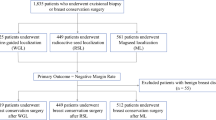Abstract
Because of disadvantages, such as the need to perform the localization and operation the same day and difficulty maintaining orientation of the center of the localization in relation to the margins of excision, alternatives to wire localization for surgery of nonpalpable breast lesions have been widely pursued. Radioactive seed localization (RSL) is one technique that has gained acceptance in many practices throughout the world and has been shown to be a safe, effective alternative to wire localization. RSL allows the localization procedure to be scheduled on a different day from the operative procedure, the operative incision to be planned with no regard for the entry point used for localization, and ongoing feedback as to the location of and distance from the lesion throughout the operation. Although RSL is an attractive technique that is intuitive to learn, beginning a new RSL program entails a multidisciplinary effort that includes several challenges. We describe recommendations for how to start a RSL program.


Similar content being viewed by others
References
Dauway EL, Saunders R, Friedland J. Innovative diagnostics for breast cancer: new frontiers for the new millennium using radioactive seed localization. In: Surgical forum: 85th annual American college of surgeons clinic congress, vol. 50. Chicago: American College of Surgeons; 1999.
Gray RJ, Salud C, Nguyen K, et al. Randomized prospective evaluation of a novel technique for biopsy or lumpectomy of nonpalpable breast lesions: radioactive seed versus wire localization. Ann Surg Oncol. 2001;8(9):711–5
Gray RJ, Pockaj BA, Karstaedt PJ, et al. Radioactive seed localization of nonpalpable breast lesions is better than wire localization. Am J Surg. 2004;188(4):377–80.
Hughes JH, Mason MC, Gray RJ, et al. A multi-site validation trial of radioactive seed localization as an alternative to wire localization. Breast J. 2008;14(2):153–7.
Barentsz MW, Van Den Bosch MAAJ, Veldhuis WB, et al. Radioactive seed localization for non-palpable breast cancer. Br J Surg. 2013;100(5):582–8.
Cox CE, Furman B, Stowell N, et al. Radioactive seed localization breast biopsy and lumpectomy: can specimen radiographs be eliminated? Ann Surg Oncol. 2003;10(9):1039–47.
Gobardhan PD, de Wall LL, van der Laan L, et al. The role of radioactive iodine-125 seed localization in breast-conserving therapy following neoadjuvant chemotherapy. Ann Oncol. 2013;24(3):668–73.
Lovrics PJ, Goldsmith CH, Hodgson N, et al. A multicentered, randomized, controlled trial comparing radioguided seed localization to standard wire localization for nonpalpable, invasive and in situ breast carcinomas. Ann Surg Oncol. 2011;18(12):3407–14.
Murphy JO, Moo T-A, King TA, et al. Radioactive seed localization compared to wire localization in breast-conserving surgery: initial 6-month experience. Ann Surg Oncol. 2013;20(13):4121–7.
Van Riet YE, Jansen FH, van Beek M, et al. Localization of non-palpable breast cancer using a radiolabelled titanium seed. Br J Surg Soc. 2010;97:1240–5.
Donker M, Drukker CA, Valdés Olmos RA, et al. Guiding breast-conserving surgery in patients after neoadjuvant systemic therapy for breast cancer: a comparison of radioactive seed localization with the ROLL technique. Ann Surg Oncol. 2013;20(8):2569–75.
Pavlicek W, Walton HA, Karstaedt PJ, Gray RJ. Radiation safety with use of I-125 seeds for localization of nonpalpable breast lesions. Acad Radiol. 2006;13(7):909–15. doi:10.1016/j.acra.2006.03.017
Graham RP, Jakub JW, Brunette JJ, Reynolds C. Handling of radioactive seed localization breast specimens in the pathology laboratory. Am J Surg Pathol. 2012;36(11):1718–23.
Chiu JC, Ajmal S, Zhu X, Griffith E, Encarnacion T, Barr L. Radioactive seed localization of nonpalpable breast lesions in an academic comprehensive cancer program community hospital setting. Am Surg, 2014;80(7):675–9.
Sharek D, Zuley ML, Zhang JY, Soran A, Ahrendt GM, Ganott MA. Radioactive seed localization versus wire localization for lumpectomies: a comparison of outcomes. Am J Roentgenol, 2015;204(4):872–7.
Rao R, Moldrem A, Sarode V, White J, Amen M, Rao M, Andrews V, Euhus D, Radford L, Ulissey M. Experience with seed localization for nonpalpable breast lesions in a public health care system. Ann Surg Oncol. 2010;17(12):3241–6.
Author information
Authors and Affiliations
Corresponding authors
Rights and permissions
About this article
Cite this article
Jakub, J., Gray, R. Starting a Radioactive Seed Localization Program. Ann Surg Oncol 22, 3197–3202 (2015). https://doi.org/10.1245/s10434-015-4719-5
Received:
Published:
Issue Date:
DOI: https://doi.org/10.1245/s10434-015-4719-5




